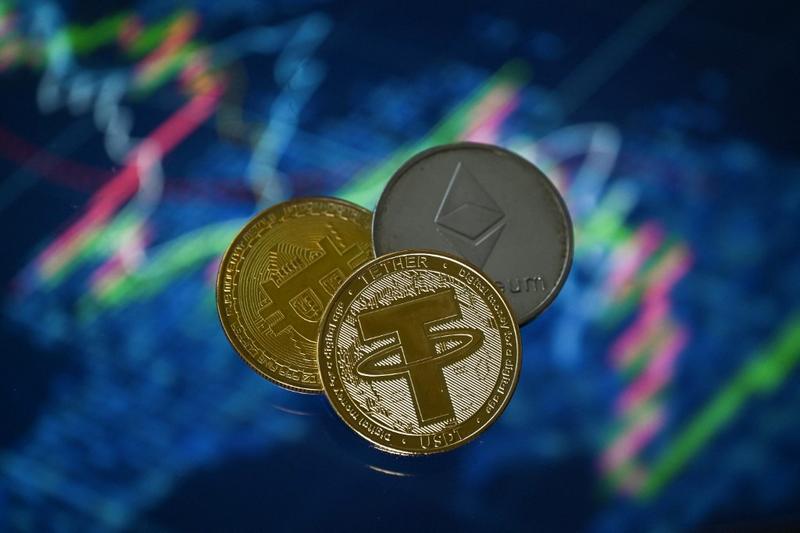 This May 08, 2022 illustration picture taken in London on May 8, 2022 shows gold plated souvenir cryptocurrency Tether, Bitcoin and Etherium coins arranged beside a screen displaying a trading chart. (JUSTIN TALLIS / AFP)
This May 08, 2022 illustration picture taken in London on May 8, 2022 shows gold plated souvenir cryptocurrency Tether, Bitcoin and Etherium coins arranged beside a screen displaying a trading chart. (JUSTIN TALLIS / AFP)
SINGAPORE/HONG KONG – Cryptocurrencies nursed large losses on Friday, with bitcoin trading near $30,000 and set for a record losing streak as the collapse of TerraUSD, a so-called stablecoin, rippled through markets.
Crypto assets have also been swept up in broad selling of risky investments on worries about high inflation and rising interest rates. Sentiment is particularly fragile, as tokens supposed to be pegged to the dollar have faltered.
Bitcoin , the largest cryptocurrency by total market value, managed to bounce in the Asia session and traded at $30,300 at 0623 GMT, up 5 percent. It has staged something of a recovery from a 16-month low of around $25,400 reached on Thursday.
READ MORE: European crypto industry steps up efforts to influence EU policy
But it remains far below week-ago levels of around $40,000 and, unless there is a rebound in weekend trade, is headed for a record seventh consecutive weekly loss.
I think what we need to see is the open interest collapse a lot more, so the speculators are really out of it, and that's when I think the market will stabilize.
Scottie Siu, Investment director, Axion Global Asset Management
"I don't think the worst is over," said Scottie Siu, investment director of Axion Global Asset Management, a Hong Kong based firm that runs a crypto index fund.
"I think there is more downside in the coming days. I think what we need to see is the open interest collapse a lot more, so the speculators are really out of it, and that's when I think the market will stabilize."
TerraUSD broke its 1:1 peg to the dollar this week, as its mechanism for remaining stable, using another digital token, failed under selling pressure. It last traded near 10 cents.
Tether, the biggest stablecoin and one whose developers say is backed by dollar assets, has also come under pressure and fell to 95 cents on Thursday, according to CoinMarketCap data, but was back at one dollar on Friday.
UNSTABLE
Selling has roughly halved the global market value of cryptocurrencies since November, but the drawdown has turned to panic in recent sessions with the squeeze on stablecoins.
These are tokens pegged to the value of traditional assets, often the US dollar, and are the main medium for moving money between cryptocurrencies or to convert balances to fiat cash.
"Over half of all bitcoin and ether traded on exchanges are versus a stablecoin, with USDT or Tether taking the largest share," analysts at Morgan Stanley said in a research note.
"For these types of stablecoins, the market needs to trust that the issuer holds sufficient liquid assets they would be able to sell in times of market stress."
Tether's operating company says it has the necessary assets in Treasuries, cash, corporate bonds and other money-market products.
But Tether is likely to face further tests if traders keep selling, and analysts are concerned that stress could spill over into money markets if pressure forces more and more liquidation.
ALSO READ: HK regulator canvasses views on rules for crypto assets
Ether , the second-largest cryptocurrency by market capitalization, steadied near $2,000 on Friday after a drop as low as $1,700 on Thursday. Bitcoin and ether are about 60 percent below record peaks reached in November.
Crypto-related stocks have also copped a pounding, with shares in broker Coinbase steadying overnight but still down by half in little more than a week.
In Asia, Hong Kong-listed Huobi Technology and BC Technology Group, which operate trading platforms and other crypto services, eyed weekly drops of more than 17 percent.
Amid the turmoil, Nomura on Friday said it had begun offering bitcoin derivatives to clients, the latest move by a traditional financial institution into the asset class.


